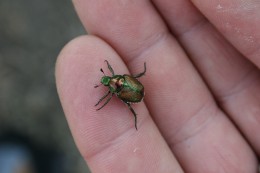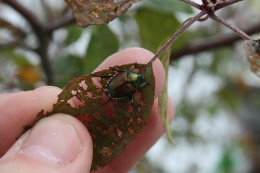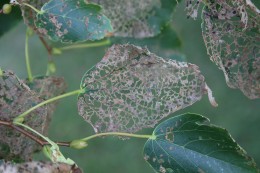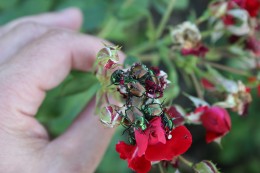By Dr. Raymond Cloyd
We have received inquiries regarding cucumber and squash plants wilting and collapsing, and a recent visit to the Manhattan Community Garden (Manhattan, KS) provided evidence that the larvae of the squash vine borer (Melittia cucurbitae) are indeed active inside plants. Squash vine borers feed on squash, pumpkin, cucumber, and muskmelon.
Adults are “clear wing” moths 5/8 inches long. The front wings are covered with scales whereas the hind wings are transparent because they do not have scales. Hind wings have red-brown hairs along the edges. The body is orange-red, with gray bands and three black markings along with orange-red hairs on the abdomen (Figure 1).
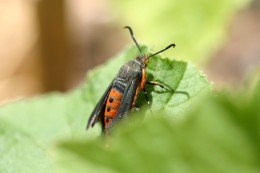
Moths are active during the day with females depositing eggs on the stem near the soil level or on stems or petioles when plants begin to flower. The eggs are red-brown, flattened, 1/30 inches in diameter, and are typically located at the base of plants (Figure 2).

A single female is capable of producing up to 200 eggs. Larvae that hatch from eggs are white, with a dark head capsule. Young larvae are 1/4 to 3/4 inches in length and taper toward the end of the abdomen (Figure 3).
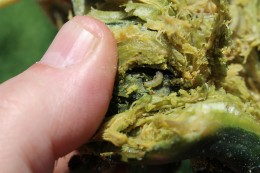
Mature or fully-grown larvae are 1.0 to 1.5 inches long (Figure 4).
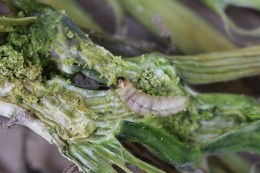
Larvae that hatch from eggs immediately tunnel into the base of plants. The larvae feed for 30 days in the plant stem, and increase in size as they mature. Typically there is only one larva per stem; however, multiple larvae may be present in a single tunnel in the stem. Mature larvae leave plants and burrow into the soil to pupate by constructing brown, silkened cocoons in which they overwinter. Squash vine borer overwinters as a mature larva in the cocoon that is located 1.0 to 2.0 inches in the soil. In early spring, the adult (moth) emerges from the soil. Squash vine borer has one generation in Kansas.
At this point, squash vine borer larvae are feeding within the internal vascular tissues inhibiting the plant’s ability to take-up water and nutrients; consequently, resulting in sudden wilting of vines and plant collapse (Figure 5).
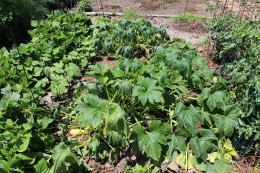
Once the larvae are inside the plant, there is little that can be done to control them or prevent damage. The tunnels inside infested plants are packed with moistened frass (fecal matter) (Figure 6).
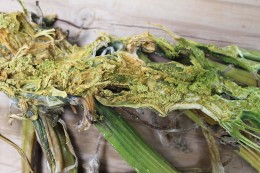
Yellow-green sawdust-like frass can also be found around feeding sites at the base of vines or plants (Figure 7)

,which will be a direct indication that larvae have entered the plant.
Since the larvae are feeding inside the plant there is not much that can be done to kill the larvae; however, there are number of plant protection strategies that can be implemented during the remainder of the growing season, including: sanitation and physical control.
Sanitation: remove and dispose of all wilted plants before the larvae leave and enter the soil. Discard all plant debris such as vines and fruits after harvest.
Physical control: rototilling in fall or spring will directly kill squash vine borer pupae or bring the pupae to the soil surface where they are exposed to cold weather or predation by birds. In addition, the process of deep plowing will bury the pupae deeper in the soil profile thus inhibiting adult emergence. Another technique that may have limited use in large plantings but may be feasible for smaller plantings is to locate infested stems and vines, create slits at the base of the plant, and then use tweezers to remove and destroy the larvae inside. The plant base should then be covered with moist soil, which stimulates the production of secondary vines and/or root growth; thus helping the plant to re-establish.
There is a new up-dated extension publication on squash vine borer (MF3309) that contains current information on plant protection with images of the insect (both adult and larva) and plant damage. You can download a PDF from the following website:
http://www.bookstore.ksre.ksu.edu/pubs/MF3309.pdf
